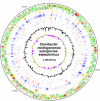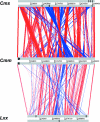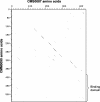Genome of the actinomycete plant pathogen Clavibacter michiganensis subsp. sepedonicus suggests recent niche adaptation
- PMID: 18192393
- PMCID: PMC2258862
- DOI: 10.1128/JB.01598-07
Genome of the actinomycete plant pathogen Clavibacter michiganensis subsp. sepedonicus suggests recent niche adaptation
Abstract
Clavibacter michiganensis subsp. sepedonicus is a plant-pathogenic bacterium and the causative agent of bacterial ring rot, a devastating agricultural disease under strict quarantine control and zero tolerance in the seed potato industry. This organism appears to be largely restricted to an endophytic lifestyle, proliferating within plant tissues and unable to persist in the absence of plant material. Analysis of the genome sequence of C. michiganensis subsp. sepedonicus and comparison with the genome sequences of related plant pathogens revealed a dramatic recent evolutionary history. The genome contains 106 insertion sequence elements, which appear to have been active in extensive rearrangement of the chromosome compared to that of Clavibacter michiganensis subsp. michiganensis. There are 110 pseudogenes with overrepresentation in functions associated with carbohydrate metabolism, transcriptional regulation, and pathogenicity. Genome comparisons also indicated that there is substantial gene content diversity within the species, probably due to differential gene acquisition and loss. These genomic features and evolutionary dating suggest that there was recent adaptation for life in a restricted niche where nutrient diversity and perhaps competition are low, correlated with a reduced ability to exploit previously occupied complex niches outside the plant. Toleration of factors such as multiplication and integration of insertion sequence elements, genome rearrangements, and functional disruption of many genes and operons seems to indicate that there has been general relaxation of selective pressure on a large proportion of the genome.
Figures





References
-
- Adelsberger, H., C. Hertel, E. Glawischnig, V. V. Zverlov, and W. H. Schwarz. 2004. Enzyme system of Clostridium stercorarium for hydrolysis of arabinoxylan: reconstitution of the in vivo system from recombinant enzymes. Microbiology 1502257-2266. - PubMed
-
- Arthur, M., F. Depardieu, C. Molinas, P. Reynolds, and P. Courvalin. 1995. The vanZ gene of Tn1546 from Enterococcus faecium BM4147 confers resistance to teicoplanin. Gene 15487-92. - PubMed
-
- Baer, D., and N. C. Gudmestad. 1993. Serological detection of nonmucoid strains of Clavibacter michiganensis subsp. sepedonicus in potato. Phytopathology 83157-163.
-
- Baer, D., A. R. White, and N. C. Gudmestad. 1998. Partial characterization of an extracellular beta-fructofuranosidase from Clavibacter michiganensis subspecies sepedonicus. Can. J. Microbiol. 44852-865.
Publication types
MeSH terms
Substances
Associated data
- Actions
- Actions
- Actions
Grants and funding
LinkOut - more resources
Full Text Sources
Molecular Biology Databases

